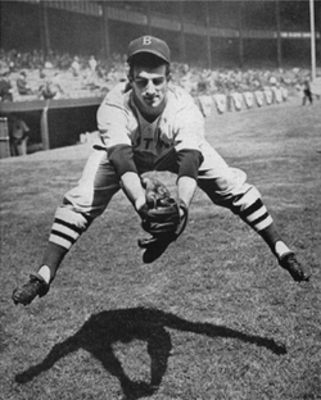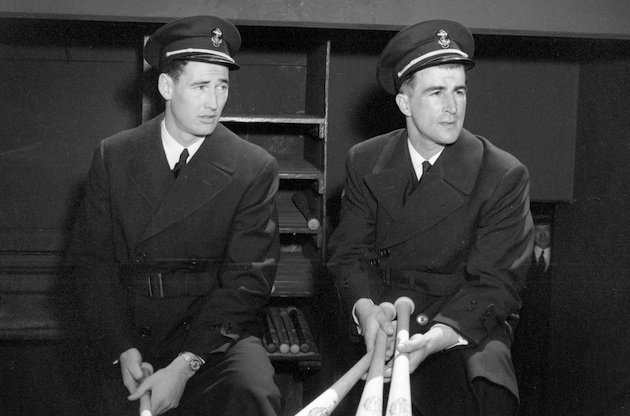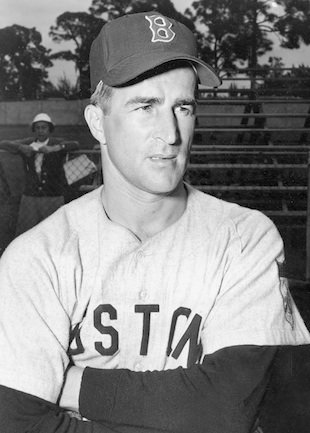 |
| Pesky is gone, but will never be forgotten |
It is a sad day in Red Sox Nation. Not because the Old Towne Team is underachieving again, two games below .500, 64-79 since last September 1st, and eleven and a half games out of first place. Not because nearly everyone on the team has been injured at some point, and those who haven't--
Jon Lester,
Adrian Gonzalez--are underperforming. And no, not because tragedy already befelled them earlier in the year when they lost beloved PA announcer Carl Beane to a heart attack/car accident (this is getting depressing). So in a season where everything has gone wrong, it was like pouring salt in an open wound when Red Sox legend
Johnny Pesky passed away yesterday at the age of 92. Appropriately, he lived long enough to take the field for Fenway Park's 100th anniversary celebration back in April, when more than 200 former players and coaches attended the ballpark's giant birthday party. After all, having a Fenway centennial without Johnny Pesky would be comparable to eating Oreos without milk; you can't have one without the other.
 |
Pesky made an immediate impact with one of the
more underrated rookie seasons in baseball history. |
John Michael Paveskovich, the son of Croatian immigrants, lived a long and full baseball life that spanned 73 years. It began when the Boston Red Sox signed him as an amateur free agent in 1940. After batting .325 in each of his two years of minor league seasoning, Pesky was clearly ready for the Show. He hit the ground running by putting together one of the more underappreciated great rookie campaigns of all time in 1942. Penciled in at the two-hole from day one, the 22 year-old shortstop used his remarkable bat control to spray line drives all over the field. Pesky was worth 5.2 bWAR after scoring 105 runs and pacing the majors with 205 base knocks. He batted .331/.375/.416, helping spark
Joe Cronin's second place Red Sox to 93 wins and earning a third place finish in the AL MVP balloting behind
Joe Gordon and Ted Williams for his efforts. He finished second to Williams (who won the major league Triple Crown that season) in the batting race and laid down a major-league best 22 sacrifice hits. What a teammate!
But
World War II interrupted his career, as it did for stars of the time such as
Bob Feller,
Hank Greenberg, and
Joe DiMaggio. Pesky served in the navy, losing all of 1943, '44 and '45. Based on his 1942 and 1946 production, one can assume that he missed out on at least 300 runs scored and 600 hits. Had he remained healthy during those years and maintained his production, he would have ended up with around 1,200 runs scored, 2,100 hits, 300 doubles, 800 walks and 2,600 total bases. Not first-ballot Hall of Fame numbers by any means, but he probably would have gained entry through a Veteran's Committee as contemporary shortstops
Phil Rizzuto and
Pee Wee Reese did. Even with the three missed seasons, his numbers are still in the same ballpark as Rizzuto's and
Lou Boudreau's. I'm not saying he belongs in Cooperstown, but you could certainly make the case. To see a more detailed comparison/argument, read
Jay Jaffe's article for SI.com.
 |
| Williams (left) and Pesky both sacrificed three prime years to the war effort |
Pesky didn't skip a beat upon returning in 1946, the best year of his career. He finished fourth in the MVP voting and set personal bests with 208 hits (first in the AL), 43 doubles,.335 batting average, .427 SLG, .827 OPS, 125 OPS+, 265 total bases, and 6.4 bWAR He earned his only All-Star selection that year as the Junior Circuit's starting shortstop in the Midsummer Classic, joining teammates Teddy Ballgame, Dom DiMaggio, double play partner
Bobby Doerr,
Rudy York,
Dave Ferriss, and
Mickey Harris. Fenway Park hosted the event that year, the first of three All-Star games that have been played in its friendly confines. Pesky went hitless in two at-bats, bouncing into a double play before
Vern Stephens replaced him in what became a 12-0 rout of the National League. But Pesky and his comrades had their eyes set on a much bigger prize, for this was the year a juggernaut Boston squad won 104 games and cruised into the World Series, heavily favored to dispose of
Stan Musial's St. Louis Cardinals. Pesky struggled in his lone Fall Classic appearance, batting just .233 with no extra-base hits, zero RBI and only two runs scored. Worst of all, he became the scapegoat for Boston's Game 7 loss when he reportedly held the ball as
Enos Slaughter made his mad dash for home, a play that defined his career and established his role in Boston's fabled "Curse of the Bambino." Pesky would spend much of his life denying any hesitation in that critical moment, and the film evidence backs him up (though he didn't get much on his relay throw the plate). The Red Sox would not capture another AL pennant until 1967, long after Pesky and company hung up their spikes for good.
"The Needle" didn't let that one mistake come back to haunt him in '47, as he once again led the league in hits, scored more than 100 runs and batted .324. But Boston's starting rotation was decimated by arm troubles to Ferriss, Harris and
Tex Hughson, causing the defending AL champs to slip to third in the standings. In 1948 he shifted over to third base to accomodate Stephens (something captain
Derek Jeter refused to do for
Alex Rodriguez more than half a century later), and while his batting average tumbled to .281 he set personal bests in runs scored with 124 and home runs with three. His strong play wasn't enough to save the Red Sox from their own manager
Joe McCarthy, who infamously bypassed
Mel Parnell in favor of journeyman
Denny Galehouse to start the do-or-die one-game playoff game against the Indians with the pennant on the line. Galehouse was bombed, and the Sox went home empty-handed. From 1949-'51 Pesky continued to floruish, batting north of .300 and posting OBPs well above .400 each season, but Boston just couldn't get over the hump.
 |
Pesky in 1952, his final season playing
with the Bosox |
Then, like so many players of the day, Pesky couldn't sustain his success for long as his career fizzled out in his early thirties. Boston included him in a massive nine player trade with Detroit on May 27th, 1952, a deal that also featured 1950 Rookie of the Year
Walt Dropo, former batting champion/future Hall of Famer
George Kell, plus All-Stars
Hoot Evers and
Dizzy Trout. After enduring an abysmal start to the season (.149/.313/.179 through 35 games) in Beantown, Pesky failed to improve much in the Motor City. His days as an everyday player were behind him. The following season he slid over to second base and bounced back to bat .292. But his resurgence was short lived, and his career was winding down. In 1954 he found himself riding the pine more often than not. Detroit swapped him with Washington's
Mel Hoderlein, a professional benchwarmer, indicating that the end was near. Fittingly, Pesky played his final game at Fenway Park against the Red Sox on September 24th, 1954. The Senators released the 35 year-old veteran during the offseason, then the Orioles took a flier on Pesky before they, too, released him just before the '55 season got underway.
The playing phase of his career was over, but the second stage of his baseball life had just begun.
Ironically, he got his first coaching gig with the New York Yankees organization in 1955 for their Triple-A organization. He returned to Detroit as a manager in their farm system from '56 through 1960. In '61, the year
Mickey Mantle and
Roger Maris captivated the naiton with their thrilling home run chase, Pesky's career came full circle when he rejoined the Boston Red Sox, first as a Triple-A manager in the Pacific Coast League. After guiding the Seattle Rainiers to a pair of winning seasons, Tom Yawkey named him as Red Sox manager after promoting
Pinky Higgins to general manager.
Unfortunately, Pesky inherited a team with a reputation as a country club because it was neither very good nor very motivated. The once-proud franchise was mired in a lengthy rut as they paid the price for being the last team to integrate, and were content to finish in the second division while the Yankees ran away with the pennant every year. To his credit, Pesky tried to change that culture and light a fire under his team, but the stubborn veterans did not co-operate (Four years later,
Dick Williams brought the same intentions and succeeded because the "Impossible Dream" team was so young and impressionable). As always, the 1963 Bosox had a formidable lineup headed by the slugging "Dr. Strangeglove"
Dick Stuart, slick-fielding All-Star third baseman
Frank Malzone and
Carl Yastrzemski, the Splendid Splinter's replacement in left field who would win the first of three batting titles that season. Surprisingly, the Sox jumped out to an 18-11 start and were in first place as late as May 19th, but couldn't maintain their hot start and quickly faded as the weather heated up. The pitching faltered and the beleaguered Bostonians finished with 76 wins, the same number of games they won the year before. In '64 they were even worse, dropping 90 games before Pesky was dismissed with two games remaining on the schedule (which the Red Sox would lose under new skipper
Billy Herman). The potent lineup, bolstered by teenage rookie sensation
Tony Conigliaro, simply couldn't score enough runs to cancel out the damage done by an atrocious pitching staff. At a time when baseball was becoming dominated by pitching, Pesky simply didn't have the necessary arms at his disposal to compete.
 |
Pesky remained a familiar face at Fenway well
into his golden years |
After a four year hiatus with the Pirates organization, Pesky returned to the Red Sox for good in 1969. And the rest, as they say, is history. He served as a color commentator on both radio and TV, then donned the Red So uniform again in 1975 as a first base coach under manager
Darrell Johnson, who helmed a colorful bunch--led by Gold Dust Twins
Jim Rice and
Fred Lynn--to the American League pennant. Three decades later it must have felt like deja vu for Pesky given the many parallels between the trajectories of the late 1970s Red Sox and their forefathers from the 1940s; the Sox coasting to the Series but just miss out on the title by falling short in Game 7. Boston's young, talented nucleus poised to launch a dynasty that never was, thwarted by incompetent managers, bad breaks and late season collapses while the hated Yankees continued to add to their impressive October history. In 1980 he was both a batting coach and a bench coach before filling in as interim manager after
Don Zimmer was fired with five games left in the season (the slumping Sox were defeated in all but one). He resumed his duties as a coach through 1984 before becoming a special instructor, the title that he held until his final breath.
Some more interesting stats from Pesky's playing career;
- He finished his career with 662 walks versus just 218 strikeouts, an incredible 3:1 ratio. In 1951 he drew 100 free passes while whiffing just 19 times in 573 plate appearances. Times sure have changed.
- One thing Pesky didn't do was hit for power, as his seventeen career homers--only six of which came at Fenway--.386 SLG and .079 ISO (that's Juan Pierre territory) can all attest. In 1947, he piled up 719 plate appearances and somehow went homerless. His diminuitive, Dustin Pedroia-like stature (5'9, 168 pounds) probably had something to do with that. In fairness though, his job was to get on base and set the table for Boston's big bats, a role in which he excelled. His phenomenal career .394 on-base percentage would make Billy Beane smile, ranking higher than greats such as Rod Carew, Joe Morgan, Frank Robinson and Tony Gwynn. As he matured he began trading hits for walks, reaching triple digit walk totals in 1949 and 1950.
- Pesky wasn't a good basestealer, either, as he was caught stealing in 49 of his 102 attempts. Interestingly, 20 of his 53 stolen bases came in the month of August.
- .321 career batting average at Fenway Park.
- Had six seasons where he batted north of .300.
- His career OBP is six percentage points higher than his SLG, a rarity.
- Was a second half player, batting .319/.403/.397 after the All-Star break compared to .293/.385/.374 before it.
- Hit just one home run in April, and one in September.
Sadly the man who was born on the day
Babe Ruth played his last game for the Boston Red Sox, who accepted less money to sign with them and went on to dedicate 61 years of his life--sticking with them through the good times and the bad--to the organization, who has the right field foul pole named after him and his number six
retired on the grandstand roof in America's most beloved ballpark, who became a franchise icon, a Red Sox ambassador and member of the team's Hall of Fame, is gone.
But the memories, his accomplishments, and the impact he had on the game lives on. We'll miss you, Johnny Pesky. The Red Sox won't be the same without you.
 |
| Pesky tips his cap to the Fenway Faithful |






No comments:
Post a Comment